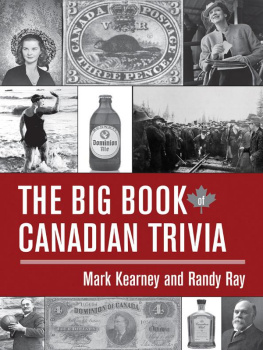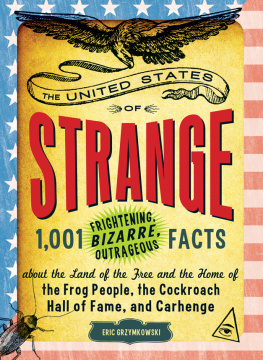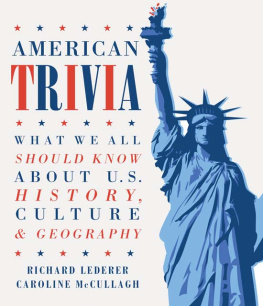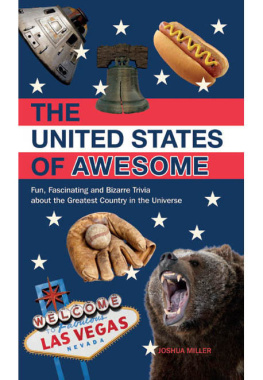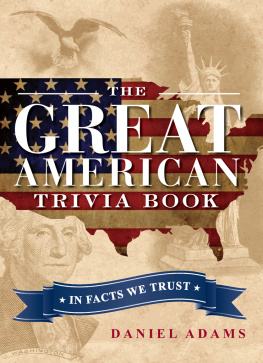Contents
THE
UNITED STATES
OF
TRIVIA
W ILLIAM M ac K AY & M AUREEN S LATTERY



An Imprint of Sterling Publishing
387 Park Avenue South
New York, NY 10016
FALL RIVER PRESS and the distinctive Fall River Press logo are registered trademarks of Barnes & Noble, Inc.
2014 by Fall River Press
All rights reserved. No part of this publication may be reproduced, stored in a retrieval system, or transmitted, in any form or by any means (including electronic, mechanical, photocopying, recording, or otherwise) without prior written permission from the publisher.
Jacket design by David Ter-Avanesyan
ISBN 978-1-4351-5380-6
For information about custom editions, special sales, and premium and corporate purchases, please contact Sterling Special Sales at 800-805-5489 or specialsales@sterlingpublishing.com.
www.sterlingpublishing.com
To Ellen Pease, a dear friend and a superlative sister

The authors wish to thank Rick Campbell, Sallye Leventhal, Mike Katz, Heather Rodino, and, of course, our editor Chris Barsanti.


1 Q:
How did a nineteen-year-old Clovis, New Mexico, teenager change what we know about prehistory in the Americas?
2 Q:
Hundreds of years before the arrival of Columbus, the Anasazi, or Ancient Ones, established their own thriving culture in the Four Corners region of the American Southwest. What was the most spectacular accomplishment of these ancestral Puebloans?
3 Q:
What happened to the Anasazi?
4 Q:
Which American city boasts the longest continuous habitation by Europeans?
5 Q:
What is the oldest state capital city in the United States?
1.Boston, Massachusetts
2.Frankfort, Kentucky
3.Santa Fe, New Mexico
4.Richmond, Virginia
5.Providence, Rhode Island
1 A: When former Boy Scout James Ridgley Whiteman found stone tools associated with mammoth bones in 1929, he knew that he had made a significant discovery and wrote to the Smithsonian Institute about his find. Later radiocarbon tests established that these Clovis points had been made approximately 13,500 years ago, pushing back the date of humans in the New World by thousands of years. Subsequent archaeological digs in Chile, Brazil, and Pennsylvania have extended the timeline even further back.
2 A: The Anasazis masterfully planned and executed cliff dwellings are among the architectural wonders of the New World.
3 A: No one knows for certain. For decades archaeologists and historians have been debating the causes of the sudden collapse of the Anasazi empire in the late thirteenth century. Theories have ranged from environmental stress caused by rapid climatic changes to disease, warfare, and even cannibalism.
4 A: St. Augustine, Florida. Founded in 1565 by Spaniard Pedro Menndez, the settlement was established forty-two years before the English colonized Jamestown, Virginia.
5 A:
New Mexico only became a state in 1912, but its capital city was first settled more than three centuries earlier, in 1609.
6 Q:
According to legend, one early Spanish conquistador was on a personal mission when he landed in what would later become a U.S. state. Name the explorer, the state, and his supposed secret purpose.
7 Q:
Where was the Lost Colony and how did it get lost?
8 Q:
What clues were found at the site about the missing English settlers?
6 A: That Ponce de Len landed in present-day Florida in 1513 and gave it its name is beyond dispute. What appears to be apocryphal, however, is that he was searching for a mythical Fountain of Youth. In any case, he didnt find it: Just eight years later, at age forty-seven, he was killed by a poison arrow.
7 A: In 1587, English settlers reestablished a colony on Roanoke Island, although the island had been the site of an Indian massacre just the previous year. When Governor John White returned from an extended resupply trip to England in 1590, he found the island deserted, dismantled, and perhaps plundered. Theories abound, but no one knows for sure what happened to the 117 colonists.
8 A: Whites crew found the word CROATOAN carved onto a fence post and CRO cut into a nearby tree. Because all the houses and fortifications had been dismantled and not simply abandoned, White concluded that their departure had not been hurried and that for some reason, the Roanoke contingent had relocated to Croatoan Island (now Hatteras Island). Unfortunately, Whites sailors refused to pursue the lead because a massive storm was brewing. In recent years, a DNA project has been undertaken to determine whether Lost Colony survivors might have intermarried with local Native Americans.
9 Q:
When was tobacco first grown for smoking and chewing purposes?
10 Q:
When did the Pilgrims land on Plymouth Rock?
11 Q:
In 1620, colonists signed a concise 200-word declaration that has rightly come to be regarded as a major document in American history. Identify this landmark agreement.
12 Q:
There were eighteen adult women among the Mayflower Pilgrims; how many survived until the first Thanksgiving in 1621?
9 A: The natives of the Americas used tobacco as far back as 2,000 years ago. Columbus, an apparent convert, brought the plant back to Spain, where its use (to the chagrin of many) spread throughout Europe.
10 A: The short answer is that they didnt: In 1620 they first made landfall in the New World at what is now Provincetown. The dubious story of a Plymouth Rock landing was first told by Thomas Faunce, a ninety-five-year-old who told the tale more than a century after the pilgrims arrival.
11 A: The Mayflower Compact. By signing the covenant on November 11, forty-one Plymouth settlers agreed to establish a civil body politic, a government in their new home. Many historians view this document as the beginning of constitutional government in America. Others, obviously more cynical, dismiss it as no more than a temporary fix designed to avert a possible mutiny.
12 A: Four. None of them died during the two-month journey, but once they arrived at Provincetown, the women were confined to the ship while the men built houses on shore. The boats damp and dirty conditions led to the high mortality rate.
13 Q:
In what year did Pocahontas marry Captain John Smith?
14 Q:
What story about Pocahontas and Captain John Smith has been told and retold; recreated in plays, movies, and books; and is still controversial among scholars?
15 Q:
What does the state name Oklahoma mean in the Choctaw language?
13 A: She never did. This Native American woman, whose real name was Matoaka, converted to Christianity and was baptized as Rebecca. In 1614, she married Englishman John Rolfe. Two years later, she and her husband sailed to England, where she was presented at the court of James I. Before she could return to America, she contracted smallpox and died.



